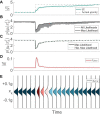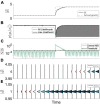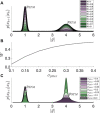Modeling orientation perception adaptation to altered gravity environments with memory of past sensorimotor states
- PMID: 37547052
- PMCID: PMC10399228
- DOI: 10.3389/fncir.2023.1190582
Modeling orientation perception adaptation to altered gravity environments with memory of past sensorimotor states
Abstract
Transitioning between gravitational environments results in a central reinterpretation of sensory information, producing an adapted sensorimotor state suitable for motor actions and perceptions in the new environment. Critically, this central adaptation is not instantaneous, and complete adaptation may require weeks of prolonged exposure to novel environments. To mitigate risks associated with the lagging time course of adaptation (e.g., spatial orientation misperceptions, alterations in locomotor and postural control, and motion sickness), it is critical that we better understand sensorimotor states during adaptation. Recently, efforts have emerged to model human perception of orientation and self-motion during sensorimotor adaptation to new gravity stimuli. While these nascent computational frameworks are well suited for modeling exposure to novel gravitational stimuli, they have yet to distinguish how the central nervous system (CNS) reinterprets sensory information from familiar environmental stimuli (i.e., readaptation). Here, we present a theoretical framework and resulting computational model of vestibular adaptation to gravity transitions which captures the role of implicit memory. This advancement enables faster readaptation to familiar gravitational stimuli, which has been observed in repeat flyers, by considering vestibular signals dependent on the new gravity environment, through Bayesian inference. The evolution and weighting of hypotheses considered by the CNS is modeled via a Rao-Blackwellized particle filter algorithm. Sensorimotor adaptation learning is facilitated by retaining a memory of past harmonious states, represented by a conditional state transition probability density function, which allows the model to consider previously experienced gravity levels (while also dynamically learning new states) when formulating new alternative hypotheses of gravity. In order to demonstrate our theoretical framework and motivate future experiments, we perform a variety of simulations. These simulations demonstrate the effectiveness of this model and its potential to advance our understanding of transitory states during which central reinterpretation occurs, ultimately mitigating the risks associated with the lagging time course of adaptation to gravitational environments.
Keywords: Bayesian; astronaut; internal model (IM); multisensory integration (MSI); otolith; vestibular.
Copyright © 2023 Allred, Kravets, Ahmed and Clark.
Conflict of interest statement
The authors declare that the research was conducted in the absence of any commercial or financial relationships that could be construed as a potential conflict of interest.
Figures







References
-
- Bar-Shalom Y., Li X.-R., Kirubarajan T. (2001). Estimation, tracking and navigation: theory, algorithms and software. Hoboken, NJ: Wiley.
Publication types
MeSH terms
LinkOut - more resources
Full Text Sources
Miscellaneous

